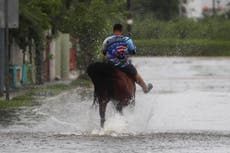Hurricane Fiona: Puerto Ricans show how they have saved themselves from power outages with solar panels
The panels can provide a backup to the cantankerous power grid on the island, where blackouts are common even without hurricanes


As Hurricane Fiona swept across Puerto Rico this week, power outages followed — leaving essentially the entire island in the dark at one point during the storm.
While most of Puerto Rico remains without power, even as the storm has moved on, some residents have kept the lights on by supplementing the island’s electrical grid with solar panels.
Solar power’s success during the hurricane was limited to a few select communities that have had solar arrays installed. But even this limited success demonstrates a potential climate-friendly way to mitigate the impacts of increasingly extreme disasters.
After Hurricane Maria in 2017, some areas of Puerto Rico were without power for months on end, debilitating the island and setting up the long and ongoing challenge of rebuilding.
The island’s power grid still isn’t where it needs to be – as evidenced by this week’s massive blackouts during Hurricane Fiona. But there has been some progress in the past five years.
Since Maria hit, about 45,000 rooftop solar panels have been installed on homes and other buildings — compared to about 5,000 solar panels that had been installed before the 2017 storm, reported Canary Media.
Those panels became vital during Hurricane Fiona this week. Many buildings with solar panels had power during the hurricane’s wrath even as much of the island went dark, the outlet reported.
One fire station in a coastal town told Canary Media that solar power kept electricity on during the storm, which allowed them to receive and respond to emergency calls.
Casa Pueblo, a Puerto Rican environmental non-profit, has helped install solar panels on homes of some low-income people and those suffering with chronic diseases, Arturo Massol-Deyá, the organization’s director, told the Houston Chronicle.
Over the past few days, the organization has shared stories on Twitter of the storm’s impact on the island, and how solar arrays were helping to keep electricity flowing when the grid shut down.
“Five years after Maria, we are better prepared for disaster like the one we now face today,” Mr Massol-Deyá wrote.
Solar power has not been a panacea for the island’s electrical woes, however. The vast majority of homes in Puerto Rico still lost power during Hurricane Fiona with no potential backup – or backup based on fossil fuel-powered generators.
Part of the problem is the expense. Installing solar panels on a rooftop in Puerto Rico can cost upwards of $20,000, reported Quartz — meaning that other than some community projects or non-profit work, getting solar power backup may only be achievable for the wealthiest communities and families.
And the power grid, which really supports the island, still failed. Without widespread adoption of rooftop solar or system-wide overhauls of Puerto Rico’s energy system, most people are likely to lose power again during the next big storm.
On Tuesday afternoon, most of the island was still without working electricity, according to poweroutage.us, two days after the rains started. LUMA Energy, the company that controls the grid, has said that they’ve restored power to around 100,000 customers, out of a total of 1.5 million.
Many Puerto Ricans have expressed frustration at LUMA for ongoing energy issues.
After Hurricane Maria, the island’s power grid was transferred to LUMA in a privatization deal finalized in June 2021. But outages have continued since then, with some residents saying that they’ve even gotten more frequent, according to Reuters.
Others have blamed these failures not just on grid management, but also on decades of under-investment from the federal government, Politico notes. Puerto Rico is a US territory, and residents are US citizens, but the island lacks voting rights in Congress or for the presidency.
These challenges are only likely to grow in the coming decades as the climate crisis deepens and the planet heats up. Warmer air and oceans can supercharge a hurricane — making winds stronger and creating the potential for a lot more rainfall.
Over the past four decades, the percentage of tropical cyclones reaching Category 3 or higher — considered “major” storms — has been increasing, according to the United Nations leading climate science panel.
Join our commenting forum
Join thought-provoking conversations, follow other Independent readers and see their replies
Comments


Bookmark popover
Removed from bookmarks